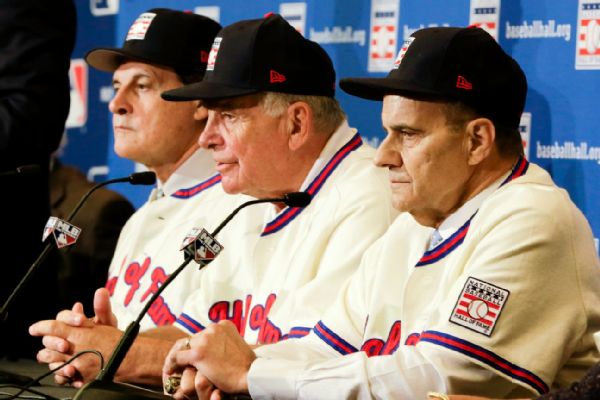|
There is nothing quite like baseball coincidences. (I won’t call them trivia, because there is nothing trivial about them.)
Dixie Walker was a teammate of both Babe Ruth and Jackie Robinson. Jimmie Reese was a teammate of the Babe and a coach for Reggie Jackson. Jefferson and Adams both died on July 4, 1826. (That’s baseball, isn’t it?) They’ve been at this game so long, every day for seven months, that eras merge, people turn out to have overlapped, even if momentarily. The other day, Shaun Clancy, the proprietor of Foley’s, the oxymoronic Irish Baseball pub on W. 33 St. in Manhattan, told my friend Curt Block that one major-league player had competed against, or was managed by, all six people inducted into the Baseball Hall of Fame last Sunday -- Bobby Cox, Tony LaRussa and Joe Torre, the managers, and Greg Maddux, Tom Glavine and Frank Thomas, the players. Shaun promised to tell us later this week when a bunch of old Hofstra athletes (and me) get together at Foley’s. I was stumped and went to the Web, trying to match careers, but that is a job for a computer, not an addled baseball-fan mind. Then another friend sent me a link to a nice article by Tim Kurkjian on ESPN.com, revealing that the player was pitcher Steve Karsay, a major-leaguer from 1993 to 2006. That ended the suspense, but my memory was already in gear because of the three managers, whom I remember as players. I knew Cox best because he showed up with the Yankees in 1968 as a minor-league third baseman with bad knees. He had spent a night or two in his car on the Fort Lauderdale beach, waiting for camp to open. He was hungry enough to squeeze 220 major-league games out of the gristle in his knees. Later Ralph Houk recommended him for coaching and minor-league managing jobs. Cox never forgot that Vic Ziegel of the good old New York Post and Steve Jacobson of Newsday and I were friendly with him. When he became a major-league manager, pennants and ejections and all, he greeted us with a smile whenever we showed up. We knew him when. I remember LaRussa as a marginal player with Charlie Finley’s A’s – an intense guy who didn’t play much, 132 games total in the majors, but often seemed to be looking around, paying attention. Joe Torre came to our attention in New York as the chubby kid brother of Frank Torre, the smooth first baseman for the Milwaukee Braves. As Joe became a star catcher, the verbal Brooklyn side of him made him a pleasure to interview. I remember him enjoying the New York Italian pun about “Chicken Catcher Torre.” Guys like Sandy Koufax, Tommy Davis, Willie Randolph and the Torres never lost their inner Brooklyn. Joe batted .297 in 2209 games. The three managers earned their chances, as baseball lifers. You never know – the player you spot in batting practice or skulking around the dugout just might wind up managing his way to the Hall of Fame in the next wave of baseball coincidences.
charlie vincent
7/29/2014 01:35:31 pm
George, it has always been my hope (though now, apparently, a failed one) that Alan Trammell would be a great manager because he is a great guy but in my judgment -- like the driver of the car who is cut off at the railroad crossing by the lowering warning arm -- just short of making it across to the other side as a player.
George Vecsey
7/29/2014 03:47:25 pm
Charlie, more than a few players in that category. Imagine how much fun it is to tell the very nice and respectful sons of Roger Maris and Gil Hodges that I thought their fathers fell just thismuch short of Hall of Fame. Maris had two of the best consecutive seasons I have ever seen a player have, and Hodges was a superb 1B for my team in Brooklyn. But...
Mendel
7/29/2014 06:09:36 pm
Surely not trivial. What makes you think they are coincidences?
George Vecsey
7/30/2014 01:27:50 am
Good point. You mean that Jimmie Reese was meant to be able to compare the Babe with Mr. October from first-hand experiences.
Mendel
7/30/2014 06:00:27 pm
Baseball does funny things to time. That such a slow game can impart "generations happen fast” is precisely its charm. My Ralph Kiner autographed baseball, which he signed when I knocked on the door of his booth in the mid-80s, is for me a precious representation of that lesson.
George Vecsey
7/31/2014 01:11:39 am
Right. Ralph Kiner played for Branch Rickey. Comments are closed.
|
Categories
All
|










